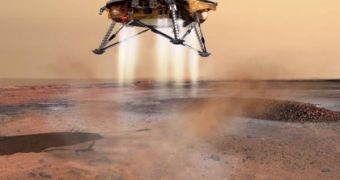The 40th Lunar and Planetary Science Conference (LPSC), held in Woodlands, Texas, saw an increased interest in the planet Mars, with a team of researchers even proposing that our neighbor might have small briny lakes under the surface, where higher temperatures allowed water to liquefy. The idea came as a result of the analysis of the first concrete pieces of scientific data that the Phoenix Mars Lander sent back to Earth, after it landed on the Red Planet, on May 25th, 2008.
The robotic probe uncovered that the Martian soil was host to perchlorate salts, compounds that were known to decrease the freezing point of water to well under minus 70 degrees Celsius. In other words, if in some portions of the ground temperatures are higher than this value, then liquid accumulations of very salty water may still form, experts from the American space agency reason.
“I do think those pools might exist. But there's still more to know about the properties of these perchlorate solutions, such as what their vapor pressure is,” Jet Propulsion Laboratory (JPL) scientist Dr Mike Hecht, from NASA's facility in Pasadena, California, said at the prestigious conference.
Phoenix got its first evidence that water definitely existed on the Red Planet right upon landing, when its thrusters created a jet Steam that peeled away the top layers of the soil. Just a few centimeters below the seemingly desert-like Martian surface, ice-water was found to exist in abundance. “Here are all these perchlorate salts right under them, by a few centimeters, is a slab of [water ice]. It doesn't take much of a stretch of the imagination to say that those two materials will interact. And once you get dampness, the perchlorate is very soluble and it will become mobile,” Dr Hecht added.
The scientist theorized that the exactly right amount and concentration of perchlorate salts in the right spot on the Martian soil could form liquid water very quickly, a piece of information that might be of paramount importance to future human missions on that location, when water supplies would be a problem and the exploration crew would have to carry all their supplies with them for a six-month, there-and-back trip.
In addition to the benefit this find may bring to a human expedition, its main advantage is that it may provide biologists with a new way of testing to see if the slabs contain traces of organisms that may have lived on the Red Planet millions of years ago. That is to say, in the past, ice samples heated in internal labs aboard Phoenix and the previous Viking mission were burnt, so all traces of past life were destroyed as the ice melted.

 14 DAY TRIAL //
14 DAY TRIAL //